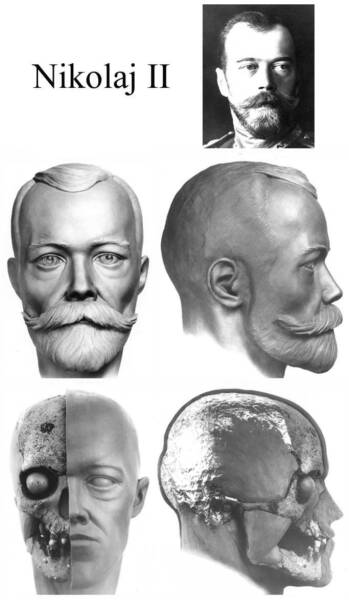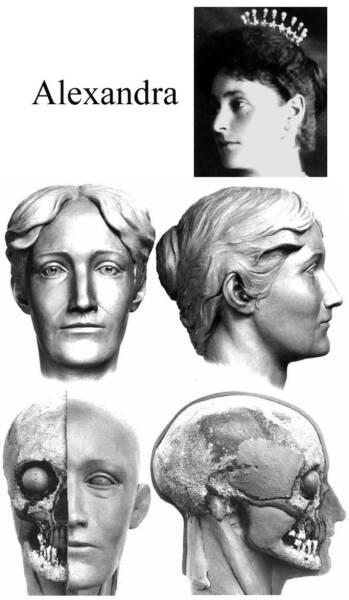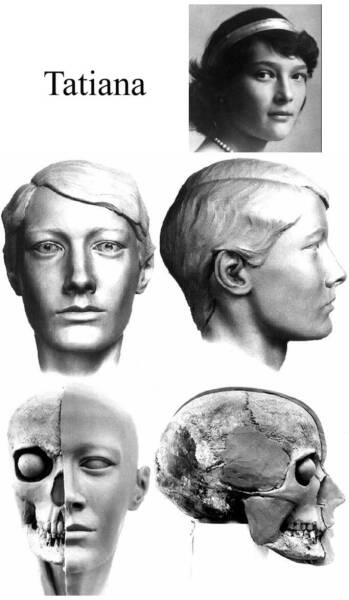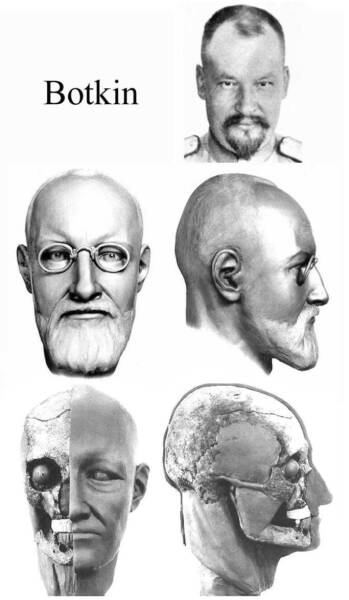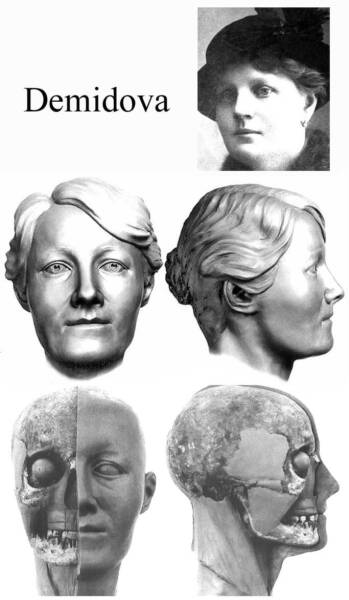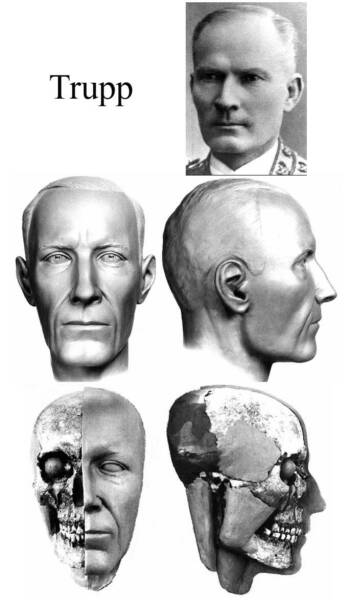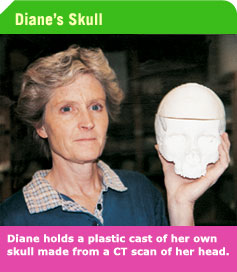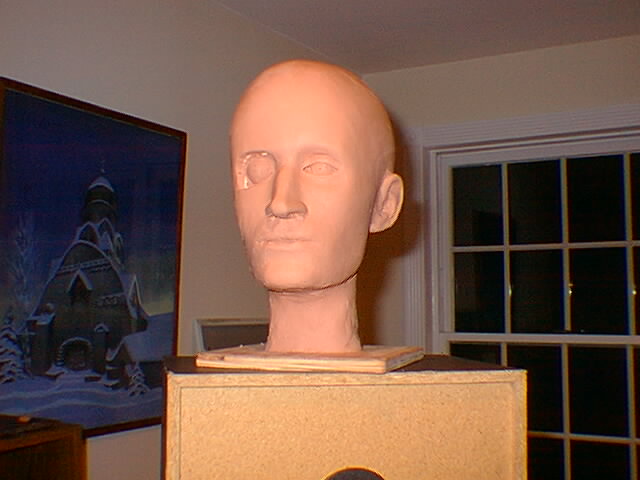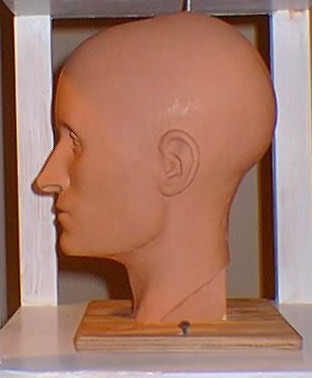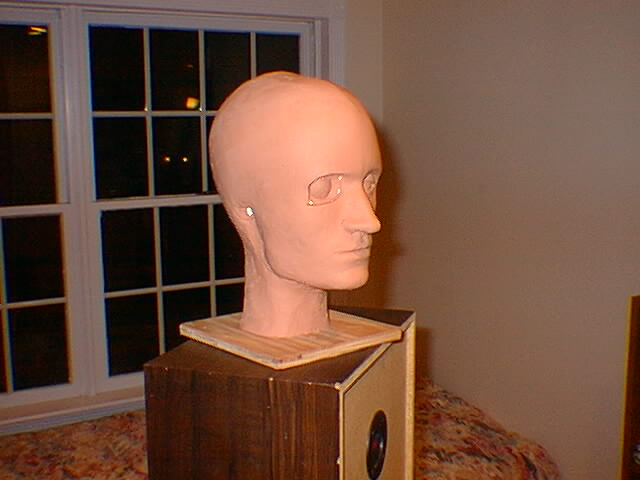RENO FORENSIC SCIENCE CONFERENCE
In 1994, Russian forensic expert, Sergey Nikitin finished the reconstruction models of the Imperial Family and their Servants by using the skull remnants found in 1991 on the Old Koptiaki road.
The portrait studies that were presented at the conference were:
- skull 1 – matched the maid, Anna Stepanovna Demidova,
- skull 2 – matched Dr Evgeny Sergeyevich Botkin,
- skull 3 – matched Olga Nikolaevna, eldest daughter of the Emperor,
- skull 4 – matched Emperor Nicholas II;
- skull 5 – matched Tatiana Nikolaevna, daughter of the Emperor,
- skull 6 – matched Anastasia, the youngest daughter of the Emperor;
- skull 7 – matched Empress Alexandra Fedorovna,
- skull 9 – matched the valet Alexei Egorivich Trupp.
- skull 8 – matched the cook, Ivan Mihailovich Kharitonov (was almost completely destroyed)
The hairstyles, moustaches and beards were modeled from period photographs.
No reconstructions were conducted on the skulls of Tsesarevich Alexei or his sister, Grand Duchess Maria, because their remains have yet to be found..
In January, 2000, Peter Sarandinaki, Director of the SEARCH Foundation sponsored Dr. Sergey Nikitin's trip to the USA and organized his stay at the American Academy of Forensic Science convention, at Reno, Nevada,,Dr. Nikitin presented his paper on his identification studies of Anastasia. It was Nikitin who in August 1991, just one month after the Imperial remains were unearthed, who first confirmed the identity of found remains. Nikitin stated that at that time there was controversy about the identification of these remains among some anthropologists and this controversy continues to this date. Nikitin was extremely well received by the American Academy. His presentation was heard by a packed reception.with standing room only. He presented the Academy with a reconstruction model of Anastasia that he made from her skull.
The following was the paper presented Dr. Sergey Nikitin at the 2000 American Academy of Forensic Science in Reno, Nevada.
Originally presented in St. Petersburg on July 17, 1998.
S. Nikitin
On July 17, 1918 the Russian city Ekaterinburg became a witness of a murder. The last Russian Emperor Nicholas II, Empress Alexandra Fedorovna, their five children and four servants were killed. In total 11 people died. The murderers took the dead bodies to one of the local forests where the bodies of Tsesarevich Alexei and one of his sisters were possibly burned and all the rest – buried in the road. In 1979 A. Avdonin and G. Ryabov discovered the place and after in 1991 the place of the burial was completely opened the scientists found the remains of 9 people: four males and two women and three girls. After the extraction all skeletons received individual numbers. By June 1992 Russian and American experts determined that the discovered remains really belonged to the Emperor, Empress, three of their daughters and the four servants. Both Russian and American experts agreed that one of the girl skeletons belonged to Olga, but the parties disagreed about the remains of the other girls. The Russians identified skeleton 5 as belonging to Tatiana, No. 6 – Anastasia. The Americans believed that No.5 is the remains of Maria and No. 6 – Tatiana.
In 1993-1998 experts from Great Britain, the United States, Canada and Russia arranged a series of genetic tests that confirmed that some of the discovered remains did belong to the Emperor, the Empress and their three daughters (they did not specified the exact names, of course).
So, today we have a disagreement about No. 5 and No. 6 that can belong to two of the three Grand Duchesses: Tatiana (21), Maria (19) and Anastasia (17).
The personification in this case can be done through comparison of the three anthropological characteristics of the supposed persons:
1. Age.
2. Height (body proportions).
3. Features of the face (head).
Age.
The Russian Commission that consisted of leading docimasy experts and anthropologists, determined the age of the girl whom skeleton No. 5 belonged, as being 18 to 22 years, and No. 6 – 16 to 20 years. These results do not allow us to exactly determine the names of the murdered girls because, keeping in mind the above mentioned age limits, skeleton No. 5 could belong to both Maria and Tatiana and No. 6 – both Anastasia and Maria.
Height.
The length of the main bones that help determine the age of the murdered (the right femur and shinbone): No. 5 – 472mm and 383mm, No. 6 – 448mm and 355mm (the total difference in the bone length – 52mm). See Picture 1
As different experts think (Rolle, Manuvrie, Pirson, Telkkja, Throtter, Naynis, Harmus, Bondyrev, Deupertoui) the height of the girls with the above mentioned bone length might be the following:
- No. 5 – 164.1cm to 176cm which is in average 170.05±5.7cm.
- No. 6 – 158.4cm to 165.2cm which is in average 161.8±3.4cm.
However, there is another possible variant – with the difference in the length of the legs (52mm) girls No. 5 and No. 6 could be of the equal height.
Height measurements of the Grand Duchesses are not available, therefore I decided to determine their approximate height using several photographs taken in June of 1917.
Later photographs could not be found. On one of the photos, next to Marie stands a soldier with an S. Mosin type rifle. The length of the rifle with bayonet is exactly 173.2 + 0.5 cm. Maria is shorter by 3-4 cm. i.e. her height one year before her death was approximately 170 cm. See Picture 2.
On another photograph Maria stands in line with her sisters. By comparing them to Maria I determined the other sister’s approximate height: Olga 167 cm, Tatiana 170 cm., Anastasia 160 cm. On this same photograph is seen that the level of Maria’s waist is lower than Tatiana’s waist by approximately 5 cm. i.e. Tatiana’s legs, while being the same height as Maria, are longer by approximately 5 cm. See Picture 3.
From the information and facts collected, we can conclude that Skeleton No. 5 (with longer femur and longer tibia) could belong to Tatiana but not to Maria. Therefore, what is left is to determine to whom Skeleton No. 6 belongs - Maria or Anastasia.
Structure of their faces (heads). In 1994, I did a forensic-medical portraiture investigation to answer the question “What are the approximate outward appearances of the people whose remains were found on the Old Koptyaki Road in 1991”. By using methods of Russian specialists of anthropological reconstruction, the outward appearance of 8 people was recreated on the found skulls. It was not possible to reconstruct the outward appearance of the ninth person due to the fact that the skull was extremely damaged by acid. Along with the others, the outward appearance of a young girl was reproduced using skull No. 6. See Picture No. 4.
Further, using the program, Adobe Photoshop, through methods of superimposition, comparative reconstructive studies were done on skull No. 6 as well as photo imagery of Nicholas II’s daughters. See Picture No. 5.
First, the outward corners of the eyes, the spot directly under the nose, the lip line and the upper contour of the head were marked.
Upon superimposing the portrait reconstructed from skull No. 6, it is quite evident that with Maria the points of the corner of the eyes do not coincide. There is a partial coincidence of the points beneath the nose and a substantial difference in the height of the parietal bone. See Picture No. 6.
Upon superimposing the same reconstruction with Anastasia, there is a complete coincidence of the indicated points, and almost a complete coincidence of the upper contour of the head. The insignificant differences in the contour are explained by the partial destruction of the outer surface of the parietal bone. See Picture No. 7.
July 17, 1998. Grand Duchess Anastasia, her father – Russian Emperor Nicholas II, mother – Empress Alexandra Feodorovna, sisters – Grand Duchesses Olga and Tatiana, the Empress’s physician-in-ordinary Evgeny Sergeievitch Botkin, the Empress’s lady-in-waiting Anna Stepanovna Demidova, the Emperor’s lackey Aloysius Egorovitch Trupp and the Imperial Family’s cook Ivan Mihailovich Kharitonov, were buried in the Ekaterian side chapel of the Sts. Peter and Paul Cathedral of Saint Petersburg -- 80 years after their villainous murder by the bolsheviks.
As an experiment, to see the variation possible with facial reconstruction and to ascertain whether or not it is a valuable tool for human identification in the forensic realm, Dr. Diane France sent a plastic skull to various reconstruction experts in the United States, including Russian Medical Examiner Dr. Sergey Nikitin, to determine which one's work closest approximates the actual person. After he finished the reconstruction Nikitin, asked me who I thought it was, and I said, "Diane France". It took Nikitin three days to complete this reconstruction. Dr. France stated,” We did indeed find out that there is tremendous variation in the results of facial reconstruction on a known individual (me) and that's as far as we are willing to go”.
The Russians based their identity of Anastasia based on facial reconstruction and photo superimposition. In the U.S.A, that form of identification will not stand up in court yet. Drs. Diane France and Anthony Falsetti presented their rebuttal papers at the 2000 convention of the American Academy of Forensic Science, stating that Anastasia is missing among the found Koptiaki remains. According to Drs. Maples, France and Falsetti skeleton No. 6 could not possibly be Anastasia as the bones indicate. (To be continued)

